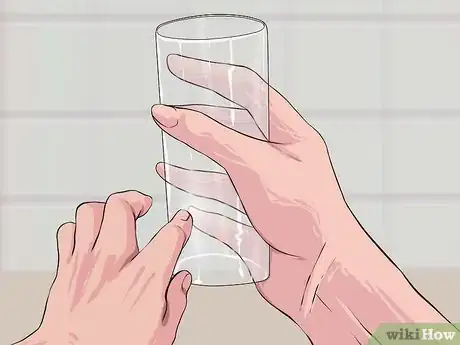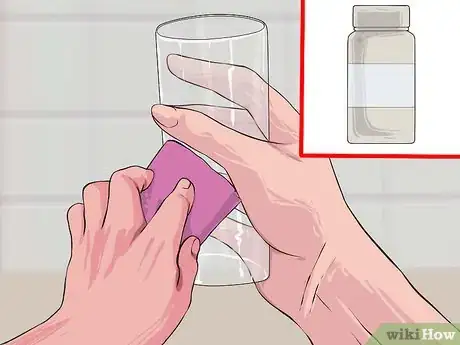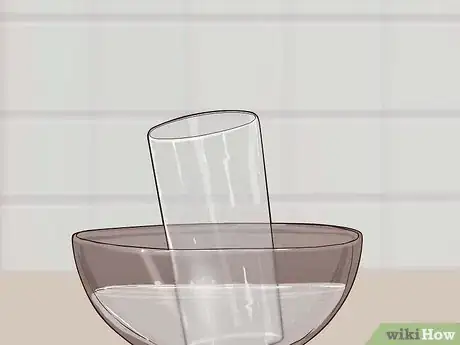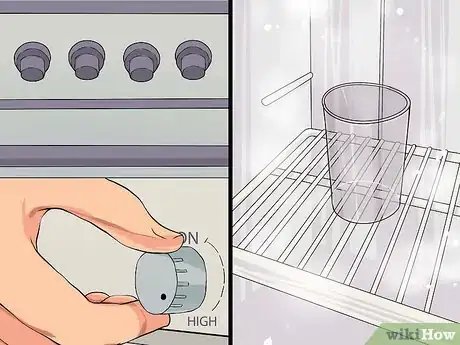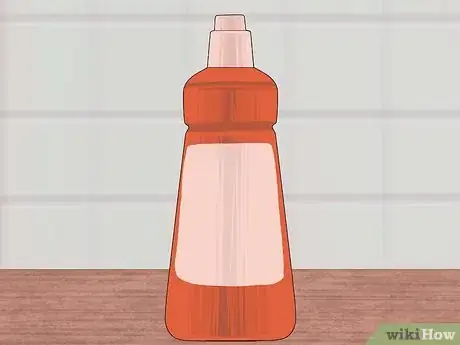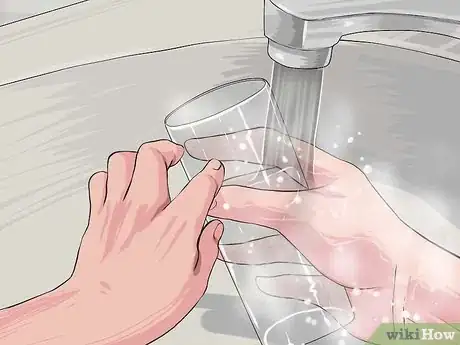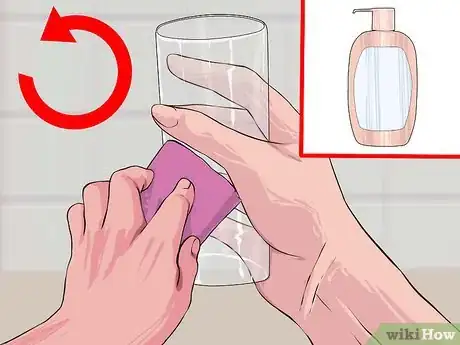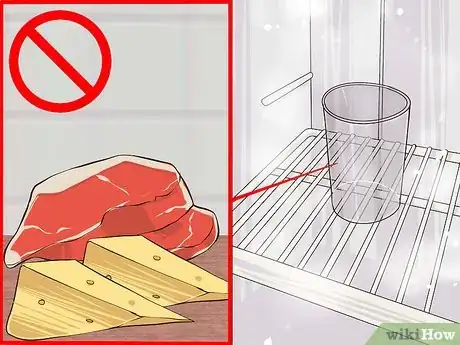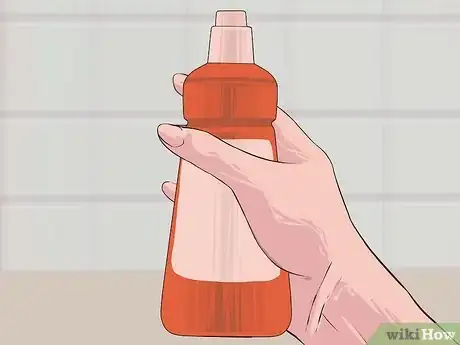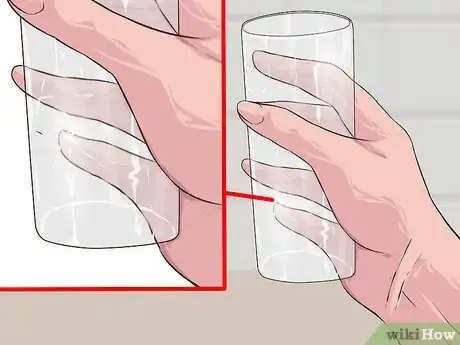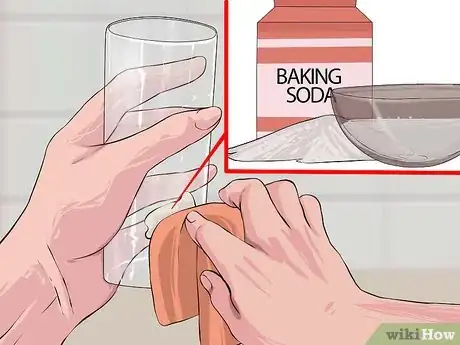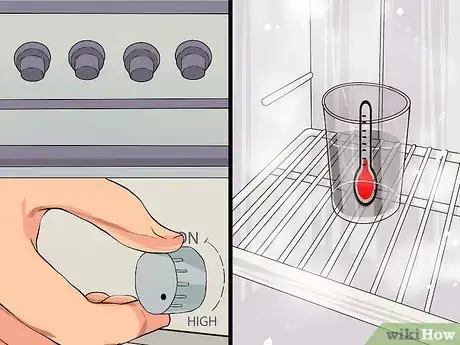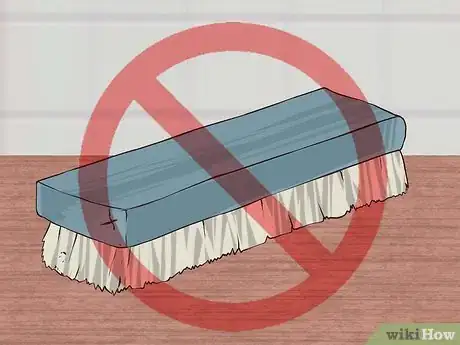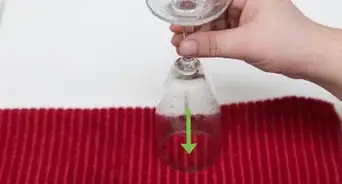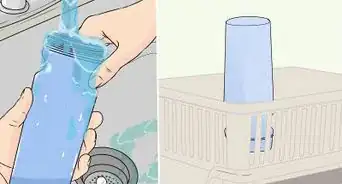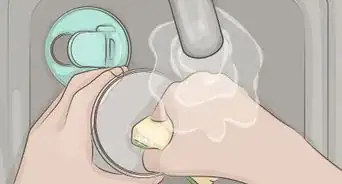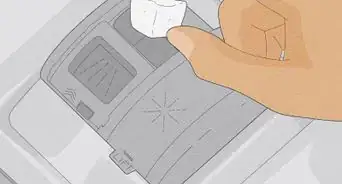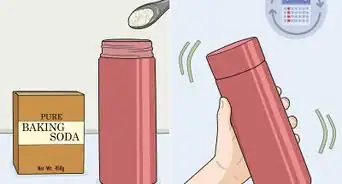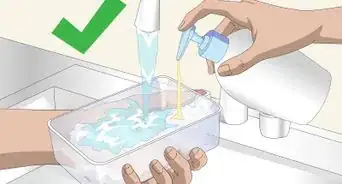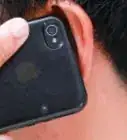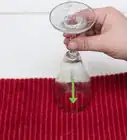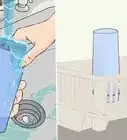This article was co-authored by Michelle Driscoll, MPH. Michelle Driscoll is the Owner of Mulberry Maids, which is based in Fort Collins, Colorado. With five years of experience, her business specializes in cleaning homes and small offices. She holds a Masters in Public Health from the Colorado School of Public Health. Additionally, Mulberry Maids has an A+ rating from the Better Business Bureau.
There are 11 references cited in this article, which can be found at the bottom of the page.
This article has been viewed 507,734 times.
Sometimes glasses emerge from the dishwasher with an unsightly film. The most common cause is hard water, which leaves mineral stains on the dishes. This article also covers stubborn food stains and etching, a problem often mistaken for hard water film.
Steps
Removing Hard Water Film
-
1Confirm the cause of cloudiness. Rub a drop of white vinegar onto the cloudy surface with your finger. If the cloudiness clears or moves around, you're dealing with a hard water film. Continue to the next step. If it stays cloudy, the glass is probably scratched. This is almost always permanent, but there are ways to prevent it from occurring.
- Do not skip this step. If you mistake scratched glass for hard water film, the treatments can make the scratches worse.
-
2Clean the cloudiness with white vinegar. Hard water films are caused by alkaline minerals in the water.[1] A mild acid will neutralize these minerals and dissolve the film. Here's how to apply it:Advertisement
-
3Soak the glass in vinegar. If the film is still there, give the vinegar more time to work:
- Wrap vinegar-soaked paper towels inside and outside the glass. (For large loads, submerge the glasses in vinegar instead.)
- Wait 15 minutes.
- Rinse in hot water.
- Try scrubbing the glasses with baking soda after you soak them with vinegar to clean them more.[4]
-
4Run the dishwasher with a special supplement. If vinegar won't cut through the film, try this treatment instead. The heat of the dishwasher should help.
- Remove all metal objects, dishes with metallic paint, and dishes with delicate patterns.
- Add citric acid crystals or a film/spot remover instead of dishwasher detergent. (Check the product label for specific instructions.)
- Adjust your water heater setting to 140ºF (60ºC). If the dishwasher is hooked up to a sink supply, run the hot water until hot.
- Run the dishwasher as usual. Run a second rinse cycle with plain water if the product label directs you to.
-
5Prevent hard water films in the future. The hard water will continue leaving a film on your dishes. Take steps to prevent this:
- Try using more detergent. Fill both of the detergent dispensers if you need to.
- Test the hot water in your house with a thermometer. If it doesn't reach 140ºF (60ºC), raise the temperature of your hot water heater.
- Buy a "rinse aid" and add it to each load according to label instructions. This product helps the water roll off your dishes, carrying minerals and food away before the dishes dry.[5]
- Install a water softener in your home for severe problems. This will also reduce hard water rings on sinks, bathtubs, and toilets.
- Remove the glasses from your dishwasher before the drying cycle starts since it could be damaging to them.[6]
Removing Food Films
-
1Wash the glass by hand. If a food film survived the dishwasher, give it a thorough hand scrub. Use plenty of soap and hot water. Most likely, this film is a protein that has set onto the glass.
-
2Scrub again with dishwasher detergent. If necessary, try again with a spot of dishwasher detergent instead of dish soap. Wear rubber gloves to protect your hands from irritation.
-
3Rinse off protein-rich food in future. Eggs, meat, and dairy products are common, protein-rich foods. The high heat of the dishwasher can cause their proteins to set onto the dishes. To avoid this, rinse off most of the food residue before you load the dishwasher.
- If a deep or round glass often ends up with food film at the base, the dishwasher spray may not reach it. Wash these glasses by hand.
-
4Use a rinse aid. A "rinse aid" product added to your dishwashing cycle will help the water roll off your dishes instead of beading up. Try this if your dishwasher fails to remove all the food gunk.
Preventing and Treating Scratches
-
1Accept that the damage is permanent. Sometimes, the cloudy "film" is actually many tiny scratches. This damage is permanent. There is no great way to hide this damage, either, so don't expect to restore it to full shine. Keep reading to give it your best shot, and prevent this happening to your other glasses.
- Do not continue until you have tried wiping off the haze with vinegar. These solutions can make hard water films worse.
-
2Polish away iridescent areas. If you notice a rainbow sheen to your glass, this is a related problem, called "silica film." Typically, the sheen is interrupted with white or solid-colored lines. Those lines are sites of irreversible damage, but you can scratch away the rainbow film.[7] Add water to a bit of baking soda or toothpaste until it forms a paste. Rub gently onto the glass, then rinse.
- You can scrape it away with a knife or pin as well, but take care not to chip or scratch the glass.
- You can use commercial glass polish instead.
- Different brands of toothpaste have different levels of abrasiveness. Look up your brand's "radioactive dentin abrasiveness" (RDA) rating online.[8] Ideally, find an RDA between 200 and 250.
-
3Prevent etching in your dishwasher. You can still save your undamaged glasses. Etching is typically caused by very soft water or very hot water. Make one or more of these changes:
- Let your sink run until its hottest point, then put a thermometer in a cup of water. If it's hotter than 140ºF (60ºC), lower your water heater settings.
- Use a no-heat dry cycle, if possible on your model.
- Do not pre-rinse dishes, unless necessary for your dishwasher.
- Use very little detergent, especially if pre-rinsing. (As little as ¼ full if your water is below three "grains" of hardness.)
- Switch to a detergent designed for soft water.
- Hand-dry valuable glassware.
- If your glasses already have etching, coat the scratches with clear nail polish and let it sit for 1 hour. Wipe any excess nail polish off with a clean cloth dipped in nail polish remover.[9]
-
4Avoid worn brushes. If your dish scrubbing brush is so worn that the plastic or metal head butts against the glass, throw it away. This could be causing the scratches.[10]
- Etching is uncommon on hand-washed dishes if you are not physically scratching it. If you still have this problem with a new brush, try reducing water temperature and the amount of soap you use.
Expert Q&A
Did you know you can get expert answers for this article?
Unlock expert answers by supporting wikiHow
-
QuestionSome of our glasses that have been used for the preparation of medications and have become cloudy. Other glasses not used for medication come out brilliant. Any advice?
 Michelle Driscoll, MPHMichelle Driscoll is the Owner of Mulberry Maids, which is based in Fort Collins, Colorado. With five years of experience, her business specializes in cleaning homes and small offices. She holds a Masters in Public Health from the Colorado School of Public Health. Additionally, Mulberry Maids has an A+ rating from the Better Business Bureau.
Michelle Driscoll, MPHMichelle Driscoll is the Owner of Mulberry Maids, which is based in Fort Collins, Colorado. With five years of experience, her business specializes in cleaning homes and small offices. She holds a Masters in Public Health from the Colorado School of Public Health. Additionally, Mulberry Maids has an A+ rating from the Better Business Bureau.
Founder, Mulberry Maids
-
QuestionDo any of these methods work on eye glasses?
 Community AnswerYou should only use products meant for eye glasses as most of them are made of plastic, not glass.
Community AnswerYou should only use products meant for eye glasses as most of them are made of plastic, not glass.
Warnings
- If your glassware has metal components, dry them immediately after cleaning. Acid or water can corrode or rust the metal.⧼thumbs_response⧽
- Avoid mixing castile soap and acid. Vinegar, citric acid, and other acidic cleaners break down castile soap into a white, messy sludge.[13]⧼thumbs_response⧽
- Pyrex (heat-resistant, borosilicate glass) can be especially difficult to clean. Wash or soak immediately after using, or it may develop a permanent haze.[14]⧼thumbs_response⧽
References
- ↑ http://www.livescience.com/34462-water-hard-ph.html
- ↑ http://csmedia2.corning.com/LifeSciences/media/pdf/CLS_AN_112_CleaningGlassware.pdf
- ↑ https://www.marthastewart.com/273273/cleaning-cloudy-glasses
- ↑ https://www.goodhousekeeping.com/home/cleaning/a38591/how-to-clean-cloudy-drinking-glasses/
- ↑ http://dishwashers.reviewed.com/features/what-the-heck-is-rinse-aid-and-why-do-i-need-it
- ↑ https://www.goodhousekeeping.com/home/cleaning/a38591/how-to-clean-cloudy-drinking-glasses/
- ↑ http://www.purewaterproducts.com/articles/glassware-wear-and-tear
- ↑ http://www.freysmiles.com/blog/view/toothpaste-abrasiveness-low-abrasive-toothpastes
- ↑ https://www.bobvila.com/articles/how-to-remove-scratches-from-glass/
- ↑ http://csmedia2.corning.com/LifeSciences/media/pdf/CLS_AN_112_CleaningGlassware.pdf
- ↑ https://scnow.com/lifestyles/article_951ca7f7-ace6-57eb-955a-5e8a28d47516.html
- ↑ http://www.ha.com/tips-for-cleaning-cloudy-glass.s
- ↑ http://www.lisabronner.com/a-word-of-caution-about-vinegar-and-castile-soap/
- ↑ http://csmedia2.corning.com/LifeSciences/media/pdf/CLS_AN_112_CleaningGlassware.pdf
About This Article
To remove a film from glasses, rub a drop of vinegar onto the cloudy surface and see if it clears or moves around. If it doesn’t move, the glass is scratched and unfixable. However, if the cloudiness moves, it is a hardwater film. Remove the film by rinsing the glass well, soaking a sponge in vinegar, and rubbing the sponge over the cloudy area. Rinse the glass in hot water when you’re done to make sure it worked. To learn how to clean stubborn films off or how to prevent scratched glasses, keep reading.
